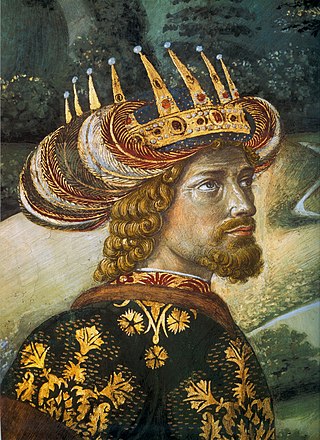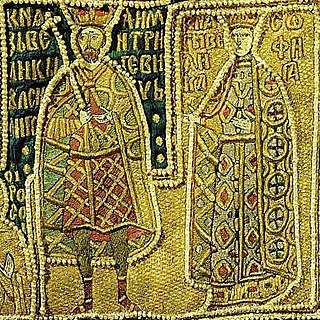Related Research Articles
The 1380s was a decade of the Julian Calendar which began on January 1, 1380, and ended on December 31, 1389.
The 1350s was a decade of the Julian Calendar which began on January 1, 1350, and ended on December 31, 1359.
The 1360s was a decade of the Julian Calendar which began on January 1, 1360, and ended on December 31, 1369.
Year 1360 (MCCCLX) was a leap year starting on Wednesday of the Julian calendar.
Year 1338 (MCCCXXXVIII) was a common year starting on Thursday of the Julian calendar.
Year 1393 (MCCCXCIII) was a common year starting on Wednesday of the Julian calendar.
The 1390s was a decade of the Julian Calendar which began on January 1, 1390, and ended on December 31, 1399.
The 1370s was a decade of the Julian Calendar which began on January 1, 1370, and ended on December 31, 1379.
Year 1377 (MCCCLXXVII) was a common year starting on Thursday of the Julian calendar.
Year 1387 (MCCCLXXXVII) was a common year starting on Tuesday of the Julian calendar.
Year 1395 (MCCCXCV) was a common year starting on Friday of the Julian calendar, the 1395th year of the Common Era (CE) and Anno Domini (AD) designations, the 395th year of the 2nd millennium, the 95th year of the 14th century, and the 6th year of the 1390s decade.

Manuel II Palaiologos or Palaeologus was Byzantine emperor from 1391 to 1425. Shortly before his death he was tonsured a monk and received the name Matthew. His wife Helena Dragaš saw to it that their sons, John VIII Palaiologos and Constantine XI Palaiologos, became emperors. He is commemorated by the Greek Orthodox Church on July 21.

John VIII Palaiologos or Palaeologus was the penultimate Byzantine emperor, ruling from 1425 to 1448.

Vasily I Dmitriyevich was the Grand Prince of Moscow, heir of Dmitry Donskoy. He ruled between 1389 and 1395, and again in 1412–1425. The raid on the Volgan regions in 1395 by the Turco-Mongol Emir Timur resulted in a state of anarchy for the Golden Horde and the independence of Moscow. In 1412, Vasily reinstated himself as a vassal of the Horde. He had entered an alliance with the Grand Duchy of Lithuania in 1392 and married the only daughter of Vytautas the Great, Sophia, though the alliance turned out to be fragile, and they waged war against each other in 1406–1408.
The names of people, battles, and places need to be spelled as they are on other articles title and then wikified.

Andronikos V Palaiologos or Andronicus V Palaeologus was the Byzantine ruler of the city of Thessalonica and surrounding territories from 1403 to his death in 1407, alongside his father John VII Palaiologos. Though they did not control Constantinople, John and Andronikos ruled Thessalonica with the full Byzantine imperial title, recognized by the ruling senior emperor, John VII's uncle Manuel II Palaiologos.

The Bistrița Monastery is a Romanian Orthodox monastery located 8 km west of Piatra Neamț. It was dedicated in 1402, having as original ctitor the Moldavian Voivode Alexandru cel Bun whose remains are buried here.
The 1400s ran from January 1, 1400, to December 31, 1409.

The mesazon was a high dignitary and official during the last centuries of the Byzantine Empire, who acted as the chief minister and principal aide of the Byzantine emperor.

The siege of Constantinople in 1394–1402 was a long blockade of the capital of the Byzantine Empire by the Ottoman Sultan Bayezid I. Already in 1391, the rapid Ottoman conquests in the Balkans had cut off the city from its hinterland. After constructing the fortress of Anadoluhisarı to control the Bosporus strait, Bayezid tried to starve the city into submission by blockading it both by land and, less effectively, by sea.
References
- ↑ Freund, Scarlett; Ruiz (1994). "Jews, Conversos, and the Inquisition in Spain, 1391–1492: The Ambiguities of History". In Perry, Marvin; Schweitzer, Frederick M. (eds.). Jewish-Christian Encounters Over the Centuries: Symbiosis, Prejudice, Holocaust, Dialogue. P. Lang. pp. 169–195. ISBN 978-0-8204-2082-0.
- ↑ Tucker, Spencer C. (December 23, 2009). A Global Chronology of Conflict: From the Ancient World to the Modern Middle East [6 volumes]: From the Ancient World to the Modern Middle East. ABC-CLIO. p. 428. ISBN 978-1-85109-672-5.
- ↑ Barker, John W. (1969). Manuel II Palaeologus (1391-1425); a study in late Byzantine statesmanship. New Brunswick, N.J.: Rutgers University Press. pp. xxiv. ISBN 0-8135-0582-8. OCLC 11370.
- ↑ Grendler, Paul F. (September 29, 2004). The Universities of the Italian Renaissance. JHU Press. p. 99. ISBN 978-0-8018-8055-1.